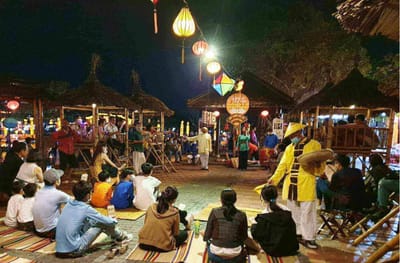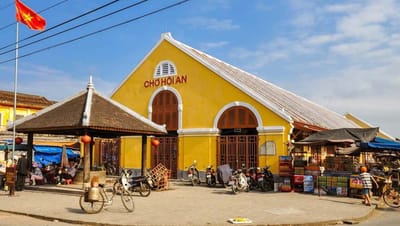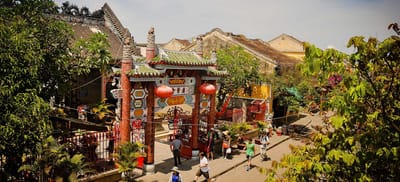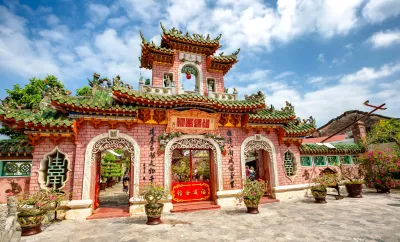Floating Lanterns in Hoi An: River Ritual & Boat Rides

Executive Summary
Ritual Essentials: Releasing floating lanterns on the Thu Bon River represents Hoi An's most accessible participatory cultural ritual—a nightly tradition (intensified during monthly Full Moon Festival) where visitors purchase biodegradable flower-shaped lanterns with candles (20,000–30,000 VND), light them while making silent wishes, and place them on the river to drift downstream. The practice blends Buddhist prayer traditions (lanterns carry wishes to ancestors and deities) with romantic visual beauty—hundreds of flickering lights floating on dark water create Hoi An's most photographed nighttime scene. Purchase lanterns from riverside vendors along Bach Dang Street, An Hoi Bridge area, or quieter spots east of the Japanese Bridge. Combine with sampan boat rides (100,000–150,000 VND per person, 20–30 minutes) for water-level perspectives of the illuminated ancient town. The ritual welcomes all participants regardless of religious belief, transforming spiritual tradition into inclusive cultural experience.
The floating lantern ritual bridges Hoi An's spiritual traditions with contemporary tourism, creating a participatory experience that connects international visitors to Vietnamese cultural practices in accessible, meaningful ways. Understanding the ritual's Buddhist origins, proper etiquette, and practical logistics enhances appreciation while ensuring respectful participation.
Cultural Origins & Spiritual Significance
Buddhist Prayer Traditions
Floating lanterns trace to Mahayana Buddhist practices honoring ancestors and seeking blessings from deities. In Buddhist cosmology, light symbolizes wisdom dispelling darkness—both literal and metaphorical ignorance. Releasing illuminated lanterns on flowing water creates a visual prayer, with the lantern representing the devotee's wish or message traveling from the earthly realm to the spiritual dimension.
Vietnamese Buddhist tradition specifically associates water lanterns with Vu Lan Festival (Ullambana/Hungry Ghost Festival, 15th day of 7th lunar month) when lanterns guide wandering spirits. However, Hoi An has adapted the practice as a year-round nightly ritual, decoupling it from specific religious calendars while maintaining spiritual significance.
The act of releasing a lantern embodies several Buddhist principles:
Impermanence (Anicca):
Watching your lantern drift away, its light gradually fading, reflects meditation on the transient nature of existence. Nothing remains static; all phenomena arise and pass.
Letting Go:
Physically releasing the lantern symbolizes releasing attachments, worries, negative emotions, and past grievances—a spiritual cleansing through ritual action.
Merit-Making:
The act generates good karma (merit) believed to benefit both the practitioner and ancestors. Vietnamese Buddhists release lanterns specifically to transfer merit to deceased relatives, improving their status in the afterlife.
Connection to Water Deities:
Vietnamese folk religion incorporates water goddess worship. Lanterns floating on rivers honor these deities, seeking protection for fishing communities and maritime travelers.
Hoi An's Adaptation
While rooted in Buddhist practice, Hoi An's floating lantern ritual has evolved into an inclusive cultural experience welcoming participants of all faiths and nationalities. Vendors frame the practice as "making a wish" rather than exclusively Buddhist prayer, lowering barriers for non-religious tourists while preserving the contemplative, hopeful essence.
This adaptation succeeds commercially (vendors sell thousands of lanterns nightly) while maintaining cultural authenticity—Vietnamese families still participate with genuine religious intent alongside tourists who appreciate the ritual's beauty and symbolism without necessarily subscribing to Buddhist theology.
[Link to: Hoi An at Night: Evening Activities for overall evening context]
![Alt text: Floating flower-shaped paper lanterns with lit candles drifting on the dark Thu Bon River in Hoi An at night, creating reflections of warm orange light on the water surface with hundreds of illuminated lanterns visible in the background near the lantern-lit ancient town riverfront and traditional wooden sampan boats]
The Lantern Release Ritual: Step-by-Step
1. Purchasing Your Lantern
Where to Buy:
Lantern vendors cluster along Bach Dang Street riverfront, An Hoi Bridge entrance areas, and smaller concentrations near the Japanese Covered Bridge and eastern riverfront sections. Vendors are easily identifiable—they display dozens of pre-made lanterns in baskets or on small carts, often calling out "Lantern! Lantern!" to passing tourists.
Lantern Types:
Traditional Flower Shape:
Most common design—lotus or rose-shaped biodegradable paper petals (usually pink, white, or yellow) surrounding a small candle set in a floating base. Simple, elegant, and widely available. Price: 20,000–30,000 VND.
Boat-Shaped Lanterns:
Elongated design resembling traditional Vietnamese boats, sometimes with small flags or decorative elements. Slightly more stable on water. Price: 25,000–35,000 VND.
Heart-Shaped Lanterns:
Romantic variation popular with couples. Same floating mechanism with heart-shaped paper structure. Price: 30,000–40,000 VND.
Large Multi-Candle Lanterns:
Premium versions with multiple candles or elaborate decorations. More photogenic but pricier. Price: 50,000–80,000 VND.
textECO-CONSCIOUS CHOICE: Request biodegradable paper lanterns over plastic-based versions. Most vendors now stock environmentally-friendly options that decompose naturally. Avoid lanterns with excessive plastic decorations, wire frames, or non-degradable materials. Responsible lantern releases use natural materials: paper, bamboo frames, and beeswax or soy candles[89][120][122].
Bargaining:
Unlike handicraft shopping, lantern prices are relatively fixed at 20,000–30,000 VND with minimal negotiation room. Vendors may offer small discounts for purchasing multiple lanterns (3+ lanterns: 50,000–70,000 VND total).
2. Preparing the Lantern
After purchase, the vendor typically provides a lighter or matches. If not, politely request one—vendors understand that many tourists lack lighters.
Lighting Process:
- Hold the lantern gently by the floating base, keeping paper petals clear of the flame
- Light the candle carefully, protecting the flame from wind with cupped hand
- Wait 10–15 seconds for the flame to stabilize and wax to begin melting (this anchors the candle securely)
- Check that the lantern floats level—adjust candle position if the lantern tilts to one side
Safety Precautions:
- Keep hair, clothing, and camera straps away from open flame
- Don't light lanterns in windy conditions (risk of paper catching fire)
- Supervise children closely during lighting process
- If the paper catches fire, quickly submerge the lantern in water to extinguish
3. Making Your Wish
This step holds the ritual's spiritual core. Vietnamese tradition emphasizes sincere, focused intention rather than casual participation.
Traditional Approach:
Hold the lit lantern in both hands, close your eyes, and silently articulate your wish or prayer. Common wishes include:
- Health and safety for family members
- Success in career, education, or business endeavors
- Finding or strengthening romantic love
- Honoring deceased relatives and requesting their spiritual protection
- Releasing worries, fears, or negative emotions
- General good fortune and happiness
Duration:
No prescribed time limit—spend as long as feels meaningful. Some participants complete their wish in 10–15 seconds; others meditate silently for 1–2 minutes.
Cultural Sensitivity:
Even if you don't hold Buddhist beliefs, approaching the ritual with sincere intention rather than treating it as mere photo opportunity demonstrates cultural respect. Vietnamese participants appreciate when tourists engage thoughtfully with their traditions.
4. Releasing the Lantern
Physical Release:
Crouch or kneel at the water's edge (most riverfront areas have stone steps or low walls facilitating easy access). Gently lower the lantern onto the water's surface, releasing it softly to avoid tipping or extinguishing the candle. The current carries the lantern downstream naturally—no need to push or throw.
Symbolic Completion:
Watch your lantern drift away for a moment. This observation period completes the ritual—acknowledging the release and transition of your wish from physical realm to spiritual journey.
Photography Timing:
If you want personal photos with your lantern, position your camera before release. Once the lantern drifts into the river current, retrieving it becomes impractical. Many visitors have companions photograph the release moment—hands extending the glowing lantern toward water.
5. Observing the Collective Beauty
After releasing your lantern, step back to observe the collective scene—dozens or hundreds of floating lights creating a "river of stars" effect on the Thu Bon River. This broader perspective captures the ritual's visual magic and communal dimension.
Peak lantern density occurs:
- Nightly: 7:30–9:00 PM (general tourism flow)
- Full Moon Festival nights: 7:00–10:00 PM (intense activity with maximum lantern concentration)
Best Locations for Lantern Releases
Bach Dang Street Riverfront (Most Popular)
The main riverfront promenade offers multiple release points with easy water access, nearby vendors, and photogenic backdrop of the illuminated ancient town.
Advantages:
- Convenient location (central ancient town)
- Multiple vendor options
- Well-lit, safe environment
- Easy photo opportunities with Japanese Covered Bridge or ancient town in background
- Sampan boat rides depart from same area (see boat section below)
Disadvantages:
- Most crowded location (peak hours = shoulder-to-shoulder tourists)
- Less intimate, more commercial atmosphere
- Harder to capture clean photographs due to crowds
Best for: First-time visitors, families, those prioritizing convenience over solitude
An Hoi Bridge Area
The pedestrian bridge connecting the ancient town to An Hoi Island provides elevated and ground-level release options.
Midpoint Bridge Release:
Some visitors release lanterns from the bridge itself (approximately 3 meters above water). This creates dramatic visual effect—lanterns falling gently to water surface—but risks lantern damage if it hits bridge supports. Exercise caution.
Island-Side Riverbank:
The An Hoi Island shoreline near the night market offers quieter release points with views back toward the ancient town. Fewer tourists congregate here despite proximity to busy market.
Advantages:
- Elevated perspectives from bridge
- Quieter ground-level spots on island side
- Proximity to night market for combined activities
Disadvantages:
- Bridge release risks damaging lantern
- Slightly less central than Bach Dang Street
- Limited vendor selection
Best for: Photographers seeking varied angles, visitors combining night market and lantern ritual
East of Japanese Bridge (Quietest)
Walking 200–400 meters east along the riverfront past the Japanese Covered Bridge leads to quieter sections with local residents releasing lanterns alongside fewer tourists.
Advantages:
- Peaceful, contemplative atmosphere
- More authentic feel (local families participate)
- Better opportunity for personal reflection
- Easier photography without tourist crowds
- River current still carries lanterns through central visible areas
Disadvantages:
- Fewer vendors (may need to purchase lantern elsewhere and carry it)
- Less infrastructure (uneven riverbank in some spots)
- Darker areas (bring flashlight for safe navigation)
- Further walk from central ancient town
Best for: Couples seeking romantic privacy, travelers prioritizing contemplative experience over convenience, photographers wanting clean compositions
Hoai River (Alternative)
The smaller Hoai River running through the ancient town offers intimate release spots, though narrower waterway means lanterns accumulate along banks rather than drifting far. Some locals prefer this location for its quieter, neighborhood character.
[Link to: Hoi An Lantern Festival Guide for monthly Full Moon Festival intensification]
Sampan Boat Rides: Water-Level Perspective
The Lantern Boat Experience
Traditional wooden sampan boats offer alternative lantern experiences—instead of releasing from the riverbank, passengers release lanterns while floating on the Thu Bon River itself, surrounded by water-level views of the illuminated ancient town.
Standard Boat Ride Format:
Duration: 20–30 minutes
Capacity: 1–5 passengers per boat (larger groups may require multiple boats)
Price: 100,000–150,000 VND per person (negotiable based on group size and duration)
Route: Depart from Bach Dang Street or An Hoi Bridge area, drift downstream and upstream covering approximately 1–2 kilometer stretch, return to departure point
What's Included:
- Traditional sampan boat operated by experienced rower
- Life jacket (optional but available upon request)
- Usually 1–2 floating lanterns per person included in price (verify before boarding)
- Gentle rowing pace allowing extended photography time
Booking Process:
Boat operators cluster along Bach Dang Street, particularly near the old ferry landing and restaurant area. They actively approach tourists on the promenade, offering "Boat ride? Lantern boat?"—negotiate price before boarding. Peak hours (7:30–9:00 PM) may allow less negotiation; earlier or later hours provide better bargaining leverage.
Advantages of Boat Releases
Unique Perspective:
Water-level viewpoint captures the ancient town's lantern-lit facades, Japanese Covered Bridge illumination, and other boats drifting nearby—compositions impossible from riverbank positions.
Extended Experience:
20–30 minute journey allows multiple lantern releases, contemplative drifting, and unhurried photography compared to quick riverbank releases.
Romantic Atmosphere:
Couples consistently rate sampan boat rides as Hoi An's most romantic evening activity—private boat, gentle water motion, lantern light, ancient town backdrop create ideal intimate setting.
Less Crowded:
Escaping the packed riverfront promenade for quiet water journey provides peaceful respite while still participating in the lantern ritual.
Local Interaction:
Boat operators often share stories about Hoi An, point out landmarks, and explain cultural traditions—informal cultural exchange enriching the experience beyond pure sightseeing.
Practical Boat Considerations
Safety:
Sampan boats are stable, low-sided wooden vessels designed for calm river navigation. Non-swimmers should request life jackets (always available but not automatically provided). The Thu Bon River remains calm in the ancient town section—no rapids or strong currents.
Weather Limitations:
Heavy rain or strong winds cancel boat operations for safety. Drizzle typically continues service. Check weather forecast and accept that plans may change.
Photography Challenges:
Shooting from moving boat requires higher ISO settings and faster shutter speeds. Bring camera strap to prevent dropping equipment into water. Smartphones work adequately but DSLR/mirrorless cameras capture better low-light results.
Tipping:
Not mandatory but appreciated. Rowers work long hours for modest income. Tip 20,000–50,000 VND for excellent service or extended tours beyond standard duration.
Motion Sensitivity:
River current creates gentle rocking motion. Individuals prone to motion sickness should consider sitting in boat center and focusing on distant shoreline (horizon stabilization).
Photography Guide
Camera Settings for Floating Lanterns
Riverbank Photography (Stationary Position):
Golden Hour Blend (6:30–7:00 PM):
Natural twilight still provides ambient light. Settings: ISO 400–800, f/4–5.6, 1/30–1/60 sec. Balance lantern glow with blue-hour sky color.
Full Dark (8:00–9:30 PM):
Minimal ambient light; lanterns provide primary illumination. Settings: ISO 1600–3200, f/1.8–2.8 (widest aperture), 1/30 sec or slower. Tripod recommended for sharpness; alternatively, accept slight motion blur for dreamy effect.
Boat Photography (Moving Platform):
Increase shutter speed to 1/60 sec minimum (compensate camera/boat motion). Raise ISO to 2500–4000 if necessary. Shoot bursts (3–5 frames) to ensure one sharp image. Image stabilization ON.
Composition Techniques
Lantern Close-Ups:
Crouch at water level, position single lantern in foreground with ancient town lights defocused in background (shallow depth of field, f/1.8–2.8). Capture flame reflection on water surface.
Wide Scenes:
Use wider lens (18–35mm) to encompass multiple lanterns, river span, and ancient town architecture. Longer exposures (1–2 seconds with tripod) smooth water and create light trails from drifting lanterns.
Human Element:
Include hands releasing lanterns, silhouettes of people against lit background, or boat operators rowing. These elements add scale and emotional resonance to purely decorative lantern shots.
Reflections:
Calm water creates mirror reflections of lantern flames—compose to include both lantern and its reflection. Shoot at water level for pronounced mirror effect.
textNIGHT PHOTOGRAPHY TIP: Avoid flash—it destroys ambient atmosphere, creates harsh lighting, and disturbs nearby participants. Modern cameras (even smartphones) handle low light adequately. If using smartphone, enable Night Mode; hold phone steady against railing or use mini tripod. Edit later to brighten shadows and enhance lantern glow[62][126].
Best Timing for Photography
Lantern Density Peak: 8:00–9:00 PM when maximum lanterns float simultaneously, creating richest visual composition
Fewer Crowds: After 9:30 PM—lantern activity continues but riverfront thins, allowing cleaner shots without tourist heads in every frame
Monthly Festivals: Full Moon Festival nights (14th lunar day) see 3–5 times normal lantern volume—spectacular but extremely crowded. Arrive early or visit less-popular release locations
[Link to: Hoi An at Night: Evening Activities for comprehensive evening photography planning]
Cultural Etiquette & Environmental Responsibility
Respectful Participation
Sincere Engagement:
Treat the ritual seriously rather than ironic tourist activity. Vietnamese participants hold genuine spiritual beliefs; mocking or cavalier behavior is disrespectful.
Quiet Contemplation:
The moment of making wishes deserves quiet. Avoid loud conversations, laughter, or group selfie chaos at the water's edge. Save socializing for before and after the release ritual itself.
Dress Modestly:
No strict dress code exists, but consider that this is a spiritual practice. Avoid overly revealing clothing; respectful casual attire aligns with the ritual's contemplative nature.
Children's Participation:
Supervise children closely—explain the cultural significance in age-appropriate terms, assist with safe candle handling, and guide them to approach the ritual meaningfully rather than as game.
Photography Restraint:
Photograph your own lantern release extensively if desired, but avoid disrupting others' experiences. Don't intrude into personal space to photograph strangers' intimate ritual moments without permission.
Environmental Considerations
Biodegradable Materials Only:
Choose paper and natural-fiber lanterns explicitly marketed as biodegradable. Refuse plastic-based versions, metal wire frames, or non-degradable decorations.
Candle Composition:
Traditional lanterns use beeswax or soy candles that burn cleanly. Avoid paraffin (petroleum-based) candles when alternative options exist.
River Health:
The Thu Bon River handles moderate lantern volume through natural decomposition and downstream flow to ocean. However, excessive plastic pollution threatens this balance. Support vendors using eco-friendly materials to sustain the tradition long-term.
Clean-Up Efforts:
Local authorities and volunteer groups organize periodic river clean-ups removing lantern remnants and other debris. Some visitors participate in morning clean-up activities—inquire at hotels about environmental volunteer opportunities.
Alternative Contributions:
If you appreciate the lantern tradition, consider donating to local environmental organizations working on Thu Bon River conservation. This financial support sustains the cultural practice by protecting the natural environment it depends upon.
Timing Your Lantern Experience
Nightly vs. Full Moon Festival
Regular Nightly Releases:
Vendors sell lanterns every evening year-round. The ritual occurs nightly with varying participation levels—modest on slow tourism nights, busier during peak seasons. This consistency means travelers can participate regardless of arrival dates.
Full Moon Festival Enhancement (14th Lunar Day Monthly):
On festival nights, lantern releases intensify dramatically—thousands of lanterns cover the river, creating the most spectacular visual scene but also maximum crowds. Vietnamese families participate with heightened religious sincerity.
Strategic Choice:
First-time visitors benefit from Full Moon Festival experience if schedules align. Return visitors might prefer quieter regular nights for intimate participation without crowds. Both options offer meaningful experiences; choose based on personal crowd tolerance and visual ambition.
Seasonal Variations
Dry Season (February–August):
Calm water, minimal rain risk, warmer evening temperatures (27–30°C). Ideal for extended riverbank time and boat rides. Higher tourist volume means more lanterns on water but also denser crowds.
Rainy Season (September–January):
Potential evening showers, cooler temperatures (22–25°C), rougher water conditions (boat rides may cancel in heavy rain). Fewer tourists create more peaceful experience. Bring waterproof gear and accept weather unpredictability.
Peak Tourism Months (December–February, July–August):
Maximum lantern activity, vibrant atmosphere, easiest vendor access, but most crowded riverfront. Book boat rides early or expect higher prices.
Low Season (March–May, September–November):
Fewer participants create intimate experiences; easier photography without crowds; better boat ride bargaining. Less visual spectacle due to lower overall lantern volume.
[Link to: Inside Hoi An Night Market for complementary evening activity]
[Link to: Seasonal Festivals in Hoi An for annual festival calendar]
Conclusion
The floating lantern ritual encapsulates Hoi An's genius for preserving cultural authenticity while welcoming international participation. What began as solemn Buddhist prayer practice has evolved into accessible evening activity that connects visitors to Vietnamese spiritual traditions without requiring religious conversion or extensive cultural expertise.
The ritual's beauty operates on multiple levels: visual spectacle (glowing lanterns on dark water), symbolic meaning (releasing wishes to spiritual realm), contemplative experience (quiet moment of intention-setting), and communal participation (shared activity transcending language and nationality). Whether you approach lantern releases as genuine spiritual practice, romantic evening activity, or photogenic cultural experience, the ritual accommodates diverse intentions while maintaining cultural dignity.
The 20,000–30,000 VND investment represents Hoi An's most affordable meaningful cultural engagement—far less than museum tickets, guided tours, or handicraft purchases, yet potentially more emotionally resonant through direct personal participation. The experience requires no advance booking, special skills, or extensive preparation; simply walk the riverfront, purchase a lantern from friendly vendors, light the candle, make your wish, and release your floating prayer into the ancient town's historic waterway.
For enhanced experience, combine your lantern release with a sampan boat ride—the 100,000–150,000 VND per person cost elevates the ritual from quick transaction to extended contemplative journey. Drifting on the Thu Bon River while releasing lanterns, surrounded by water-level views of illuminated architecture, creates Hoi An's quintessential romantic evening—a memory justifying the modest expense through unique perspective and peaceful atmosphere.
Approach the ritual with cultural respect, environmental consciousness, and sincere engagement. Your participation sustains a tradition that Vietnamese families have practiced for generations, connects you to Buddhism's core teachings about impermanence and release, and contributes one more point of light to the constellation of wishes floating downstream toward the sea, the ancestors, and the realm of hopes yet to be fulfilled.
No spam, no sharing to third party. Only you and me.






